Mastering the Dynamics of Big Wave Surfing Techniques
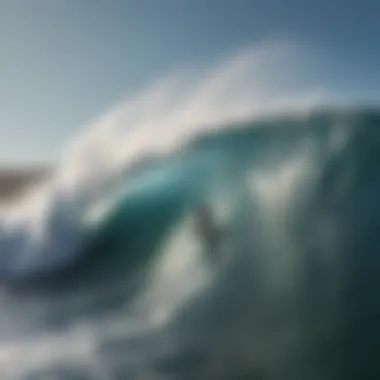
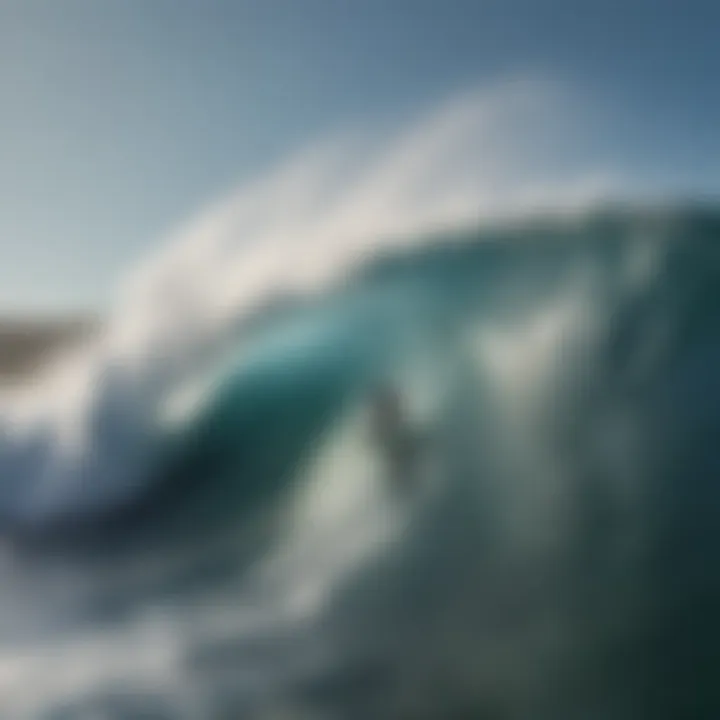
Intro
Big wave surfing is not just a sport; it's a compelling dance between human ability and the raw power of nature. The sheer scale of the waves can intimidate even seasoned surfers. These towering giants are formidable, but they also offer a thrilling challenge for those willing to embrace their might. Understanding the dance—how to interact with these waves skillfully and safely—is essential for anyone considering stepping into this demanding realm.
This article aims to unpack the myriad aspects of riding big waves, from mastering essential techniques tailored for novices to delving into advanced skills that even experienced athletes can refine. Moreover, it emphasizes the importance of safety in this high-stakes environment, where calculated risks often separate thrilling rides from near-catastrophes.
Those keen on the specifics will discover insights about gear, safety measures, and the critical interplay between community, environment, and surfing skill. By the end of this narrative, readers will grasp not only the techniques but also the respect and understanding required to conquer the ocean's might.
Techniques and Skills
Fundamental Techniques for Beginners
Starting with the basics is crucial for any aspiring big wave surfer. Some key techniques focus on the synergy between the surfer and the wave:
- Paddling Technique: A strong paddle sets you up for success. Beginners should work on their stroke efficiency, ensuring they can generate enough speed to catch the wave.
- Positioning: Where you line up on the board matters. Aim to position your body accurately to achieve maximum lift when the wave begins to break.
- Take-off: Timing the take-off is essential. When the wave rises, stick to the bottom of the wave, remain low, and keep your momentum.
- Balancing: As you rise with the wave, maintaining your balance while adjusting your stance is key. Adopt a low center of gravity to ride smoothly.
"The essence of surfing lies in the flow – feeling your way through water and air, not fighting against them."
Advanced Skills for Experienced Athletes
For those who have already tasted the thrill of large waves, the journey doesn’t end. Improving your skills, even at an advanced level, can elevate performances:
- Tube Riding: To get through the barrel, a surfer needs to perfect not just speed but also technique—understanding where to place oneself relative to the crest.
- Verticality: Mastering the drop and pump is crucial. Surfers should train to distribute their weight dynamically for better control while riding down steep faces.
- Turning Techniques: Sharp, powerful turns can enhance a surfer's ability to navigate waves effectively. Learning to utilize body weight intelligently to shift gears while riding is essential.
- Situational Awareness: Understanding wave patterns and surrounding surfers can prevent accidents. Being aware of currents and tides will help enhance overall performance and safety.
Safety and Gear
Essential Safety Measures in Watersports
Big wave surfing presents unique challenges that make it necessary for surfers to prioritize safety. Here are some fundamental safety measures:
- Buddy System: Surfers should avoid tackling big waves alone. Having a buddy not only encourages safety but ensures immediate assistance if something goes wrong.
- Site Familiarity: Knowing the surf spot intimately—understanding the dangers, currents, and entry/exit points—is vital.
- Weather Conditions: Always check weather forecasts and surf reports to be aware of wave sizes and changeable conditions.
- Emergency Protocols: Being prepared for emergencies, such as having a plan for what to do in case of a wipeout, is essential for every surfer.
Gear Reviews and Recommendations
The right equipment can make all the difference in the world of big wave surfing:
- Surfboard Selection: Opt for boards designed for big wave performance. These are typically broader and sturdier than standard boards to handle the extra force. Models like the Jedi and Gun boards are popular among seasoned surfers.
- Wetsuits: A proper wetsuit is crucial for warmth and flexibility. Brands like O'Neill and Rip Curl offer excellent options tailored for colder waters.
- Leashes and Safety Vests: Never underestimate the importance of a good leash. Safety vests can also provide added buoyancy in dire situations.
- Helmets: Though not always worn, a helmet can protect against unforeseen accidents, especially in rugged conditions.
With a solid understanding of the crucial techniques and safety measures involved in big wave surfing, any passionate surfer can approach the sport with new respect and precaution, ready to tackle the formidable forces of the ocean.
Understanding Big Wave Surfing
Big wave surfing stands apart as more than just a sport; it's a testament to the resilience and skill of surfers who confront the ocean’s might head-on. Appreciating the dynamics of this demanding endeavor requires an understanding of its history, iconic spots, and the science behind wave formation. This knowledge empowers surfers to navigate the challenges of massive swells with greater assurance.
Why is Understanding Big Wave Surfing Important?
It enhances one's ability to respect the ocean, to recognize the power it holds. Big wave surfing isn’t simply about riding a board; it's about existing in harmony with nature, adapting, and responding to its unpredictability. As surfers gain insight into the factors influencing wave size and behaviour, they are better equipped to make informed decisions about safety, technique, and the right equipment.
The History of Big Wave Surfing
Big wave surfing holds a rich past that intertwines with the cultural fabric of coastal communities, particularly in places like Hawaii, where it flourished. It was in the 1950s when pioneers like Greg Noll and Eddie Aikau began riding larger waves, pushing the boundaries of what was considered possible. These early surfers laid the groundwork for the sport’s evolution by courageously tackling giants like Waimea Bay. Today, with athletes like Garrett McNamara and Laird Hamilton at the forefront, the quest for the world's biggest wave continues, driven by innovation in techniques and technology.
Iconic Locations for Big Waves
Some beaches have carved out their niche in the collective consciousness of surfers and thrill-seekers. Here are iconic spots that symbolize big wave surfing.
Teahupo'o, Tahiti
Teahupo'o is often celebrated for its heavy, powerful surf - the kind that can intimidate even seasoned riders. Its unique reef break creates waves that can reach terrifying heights, coupled with a notoriously shallow lagoon. While the view is breathtaking, the stakes are high. Surfers flock here to experience some of the most challenging waves on Earth, though doing so requires a solid backing of skill and mental readiness. The sheer force of Teahupo'o can intimidate, but those who ride these waves often revel in the adrenaline rush it brings.
Pipeline, Hawaii
Pipeline is synonymous with surf culture. It's a right-hand reef break known for its beautiful, hollow waves. From its picturesque backdrop to its demanding conditions, it represents the pinnacle of big wave surfing. What makes Pipeline special is its consistency and ability to produce perfect tubes, which both attract surfers and challenge their skills. However, the competition for waves here is fierce, and injuries are not uncommon due to the sharp reef just beneath the surface.
Nazare, Portugal
Nazare has emerged as a phenomenon in the surf community, known for its colossal waves that often reach over 80 feet. The underwater canyon just offshore amplifies swells, giving rise to some of the largest surfable waves recorded. Like Teahupo'o, it demands respect and thorough preparation. The waves appear intimidating, but the thrill draws many surfers seeking to test their limits. However, the risk factor is significant due to the heavy currents and unpredictable conditions.
Mavericks, California
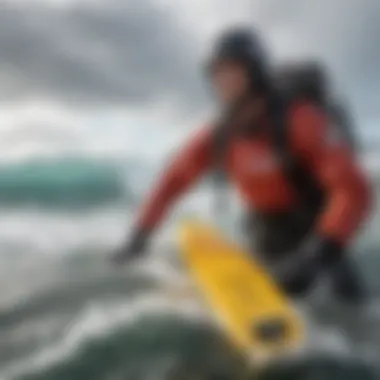
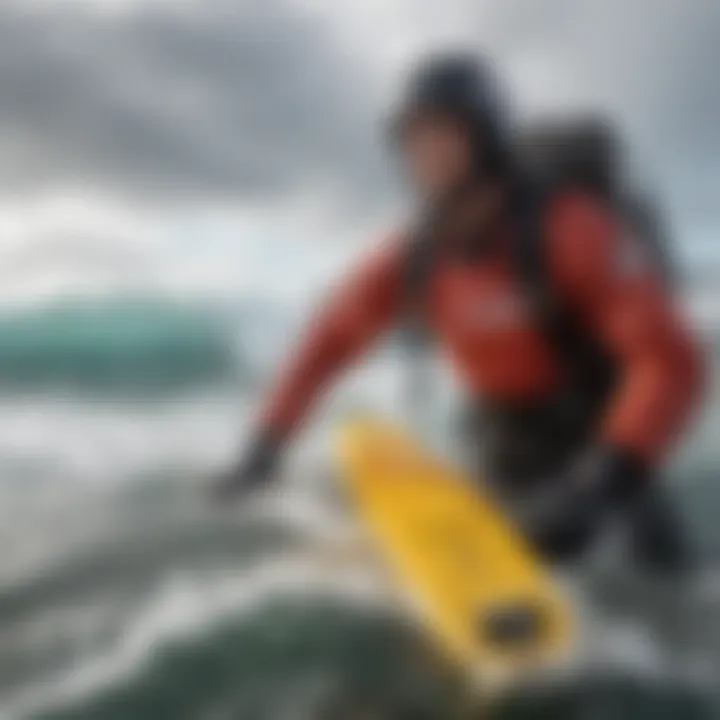
Mavericks, located near Half Moon Bay, is famous for its frigid waters and powerful waves formed by a submerged reef. Instead of simply scaling heights, the challenge here often lies in the freezing temperatures and rough waters during winter swells. Known for its intimidatory conditions, many who ride Mavericks are tested in ways far beyond only maintaining balance. Its local community of surfers is tightly knit and competitive, further adding to the allure and intensity of the experience.
The Science of Waves
The mechanics behind waves is vital for those wishing to master the art of big wave surfing. Understanding how different elements combine to create the swells surfers ride is key.
Wave Formation
Wave formation begins with wind blowing across the ocean surface, transferring energy to the water. This energy travels through the ocean, leading to the formation of waves. Bigger waves generally occur when winds are strong over vast distances, allowing energy to accumulate. Additionally, topography plays a role; underwater features can either heighten or diminish wave size depending on how they interact with incoming swells.
Wind and Swell Interaction
The interaction between wind and swells is nuanced. As waves travel, the wind's speed and direction impact their shape and strength. Optimal conditions create larger, more pristine waves, while choppy winds can roughen them up, affecting the effectiveness of surfers. Knowing how to read wind patterns can help surfers recognize when to hit the water for prime conditions.
Environmental Factors Influencing Wave Size
Many factors, such as tides, currents, and storms, influence how waves behave. Local weather systems, offshore storms, and seasonal patterns can create massive swells, often sending surfers flocking to the coastline. Recognizing these patterns can be the difference between a successful session and a treacherous outing. Environmental awareness not only enhances the surfing experience but also fosters a deeper connection with nature.
Physical Demands of Surfing Big Waves
When it comes to tackling high surf, understanding the physical requirements is paramount. Big wave surfing isn't just a casual ride; it’s a full-body workout that tests endurance, strength, and agility. Surfers must prepare both their bodies and minds to handle the incredible pressure and physical toll that comes with conquering some of the world's most monstrous waves. In this segment, we will explore the essential elements that make up the physical demands of big wave surfing, emphasizing how they can greatly enhance performance and safety in the water.
Strength and Endurance Training
An unequivocal requirement for any big wave surfer is an impressive foundation of strength and endurance. Training regimens typically amalgamate various exercises, targeting the entire body. Surfing often requires explosive movements, especially when paddling out into turbulent waters, and having strong upper body muscles aids in this endeavor.
- Core Workouts: Focusing on core strength also can't be overlooked. A strong core stabilizes the body while riding the waves, facilitating balance and fluid movements.
- Resistance Training: Moreover, engaging in resistance training — such as weightlifting or bodyweight exercises — builds both muscle endurance and explosive power.
Proper training not only boosts performance but reduces the risk of injury. Surfers tend to encounter unexpected challenges, and being physically prepared will certainly give them an edge. Without a doubt, blending strength with endurance is the winning formula for those who dare to ride big waves.
Cardiovascular Fitness
Big wave surfers also need a heart that can handle the pressure. Cardiovascular fitness is a critical element in sustaining energy during lengthy sessions in the water. The interplay between adrenaline and oxygen demands thorough preparation. Classes such as swimming, running, and cycling won't just get the heart pumping; they improve lung capacity too. Thus, a fitter heart can provide the stamina one needs when battling against nature’s fury.
As surfers continue to endure relentless exertions, their ability to recover quickly from bouts of fatigue increases. An improved cardiovascular system helps manage the physical stress experienced when surfing massive waves. Regular interval training often proves beneficial for simulating the bursts of energy required while paddling and riding
Balance and Agility
Surfing big waves demands acute balance and agility. As any experienced surfer will tell you, agility can often dictate the success of a ride. Balancing on a surfboard is akin to performing a tightrope walk while dodging obstacles that come in the form of swell and chop. Having a stable center of gravity means the difference between staying upright and taking a nasty spill.
- Fitness Boards: Many surfers incorporate balance training into their regimen, using tools like stability balls or balance boards to fine-tune their skills.
- Flexibility: Flexibility should not be overlooked as well. Incorporating practices like yoga can significantly enhance balance and core stability. Moreover, it contributes to a greater range of motion in surf-specific movements.
In summary, agility and balance, combined with well-rounded fitness, can help surfers navigate unpredictable conditions, allowing them to adjust their weight and positioning with minimal effort.
"Big wave surfing is not just a sport, it’s a test of the human spirit and physical ability."
By addressing the physical demands of surfing, enthusiasts can train effectively to not only improve their performance but also heighten their enjoyment of the sport. Whether one is a novice or a seasoned pro, understanding these elements creates a solid foundation for mastering the art of big wave surfing.
Techniques for Success
Mastering big wave surfing incorporates a set of techniques that can be critical in navigating the immense and often daunting forces of nature. Understanding and applying these methods not only enhances performance but also increases the chances of safety in exhilarating yet perilous conditions. For surfers at any level, grasping the nuances of paddling, dropping in, and riding the wave can serve as stepping stones to not only improve their skills but also build a deep respect for the ocean.
Paddling into the Wave
Paddling into a wave is no mere formality; it’s the lifeline for a surfer wanting to catch the momentum of a breaking swell. The right technique can mean the difference between getting thrown around in the surf and gliding gracefully onto your board. A strong, effective paddle is characterized by long, powerful strokes. It’s all about rhythm; timing is crucial since catching the wave at its peak will assist you in making a clean drop.
Benefits of Effective Paddling:
- Speed: Quick, smooth strokes allow you to reach the breaking point of the wave.
- Positioning: Proper paddling can help in getting the right angle on the wave, which is critical for a successful drop.
- Stamina: Forming a solid routine improves your strength and endurance, essential for engaging with big waves.
Consider fitness training that focuses on your upper body and core to achieve maximum efficiency while paddling.
Dropping In
Dropping in can be intimidating when faced with towering walls of water, but it is an exhilarating moment in surfing. Once you have positioned yourself correctly, the key to a successful drop lies in a combination of body weight management and board angle adjustments. A smooth drop requires both confidence and finesse since you essentially align yourself with the wave’s trajectory.
Key Characteristics of Dropping In:
- Body Positioning: The position of your weight can dramatically affect how you enter the wave. Bend your knees and lower your center of gravity for better stability.
- Angle of the Board: Keeping the nose of your board pointed slightly downwards can help you gain momentum as you drop.
- Stay Composed: Remember, panicking can lead to poor decision-making—it’s all about keeping a cool head.
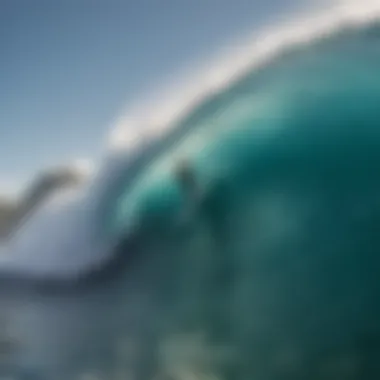

Riding the Wave
Riding the wave is where the magic happens, and different sub-techniques within this riding phase can make all the difference.
Positioning on the Board
Positioning on the board refers to where a surfer stands relative to the center of the board while riding a wave. This choice is essential as it contributes significantly to balance and control. A common saying in surfing goes, "find your sweet spot," which refers to the ideal position enabling optimal performance.
Why Correct Positioning Matters:
- Balance and Control: Proper positioning helps the surfer maintain equilibrium as the wave pushes them forward.
- Speed Management: Staying closer to the front can drive speed, while sitting back slightly can help navigate the wave’s face better.
- Avoiding Wipeouts: Stringent positioning assists in preventing falls and tumbles from sudden waves.
Turning Techniques
Turning techniques involve the body movements and board adjustments required to steer your trajectory effectively on the wave. This aspect can drastically enhance how a surfer maneuvers and adapts to varying wave shapes and behaviors.
Characteristics of Effective Turning Techniques:
- Carving: Employing a smooth, arced motion with your board will enable you to translate speed into direction.
- Weight Distribution: You must be precise with shifting your weight to execute a turn correctly, either leaning back or forward, depending on the desired direction.
- Spatial Awareness: Focus on the wave’s speed and form; your navigation depends on it.
Handling Different Wave Types
Handling different wave types is essential for any serious big wave surfer. Waves can vary significantly in terms of size, shape, and power, requiring surfers to adapt their techniques accordingly.
Significance of Adapting to Wave Types:
- Understanding Wave Behavior: Each wave might react differently during various tides and wind conditions, thus affecting your approach.
- Tailored Techniques: Different waves call for unique riding strategies; knowing when to pump water or when to cut back can make or break a ride.
- Fluidity in Movement: The ability to smoothly transition between techniques according to wave type prepares a surfer for a successful ride.
Ultimately, mastering these techniques is about blending skill with instincts, understanding how to navigate dynamic environments with skill and precision. Each session out on the water is another chance to hone these techniques, bringing every surfer closer to the waves in ways that are both thrilling and respectful.
Safety Considerations
Engaging in big wave surfing requires more than just skill; it demands a comprehensive understanding of safety. The thrill of riding massive waves can easily turn perilous without proper precautions. Safety considerations encompass various elements, from assessing natural hazards to utilizing essential gear designed to protect surfers in extreme conditions. By prioritizing safety, surfers not only enhance their own experiences but also respect the ocean's power.
Understanding Rip Currents
Rip currents are fast, narrow channels of water that flow away from the shore. Recognizing their presence is crucial for any surfer planning to take on big waves. These currents can pull anyone out to deeper water, regardless of their swimming ability. Fortunately, identifying rip currents is often straightforward. Look for choppy water, a difference in water color, or foam moving seaward.
Once you've spotted a rip current, knowing how to react can mean the difference between a painful experience and a successful surf session. Instead of fighting against the current, it's advisable to float or swim parallel to the shore until you're free from the current's hold. These currents can also occur in areas known for big waves, making understanding them a safety priority.
Personal Safety Gear
Buoyancy Vests
Buoyancy vests play a pivotal role in ensuring safety while surfing massive waves. Unlike traditional life jackets, these vests allow more freedom of movement. They’re designed to keep the surfer afloat during unexpected wipeouts, significantly improving survival chances. One remarkable feature of buoyancy vests is their flexibility, which enables surfers to paddle efficiently. Many surfers find that buoyancy vests become essential, particularly in heavy conditions where the impact of waves can be unforgiving. However, it’s worth noting that while they offer flotation and added protection, bulky vests might restrict some movements during critical maneuvers.
Helmets and Impact Protection
Helmets are often overlooked but are crucial for big wave surfing. Impact protection gear, such as foam helmets, mitigates the risk of head injuries caused by impacts with the wave or surfboard. The primary characteristic of these helmets is their ability to absorb shock, which is invaluable in high-stakes situations. With the intensity of big wave surf, a helmet can be the difference between a minor bump and severe injury. Their lightweight design ensures that surfers won’t feel weighed down, enabling them to focus on riding the waves rather than worrying about potential hazards. However, some surfers might argue that helmets lack comfort, but for others, the peace of mind they provide is indispensable.
Emergency Protocols
Having protocols in place for emergencies can save lives. Surfers should be well briefed on emergency procedures before venturing into challenging waters. It's advisable to practice rescues with fellow surfers, ensuring everyone knows how to respond in case someone gets into trouble. Critical elements of emergency protocols include:
- Establishing a clear signal system for emergencies.
- Creating a buddy system where surfers always watch each other's backs.
- Knowing the nearest lifeguard posts and having a clear escape route.
Incorporating these ensure that you are not just out there for thrill, but ensure a level of safety for yourself and your fellow surfers.
Technology in Big Wave Surfing
Technology has woven itself into the very fabric of big wave surfing, enhancing every aspect of the sport. From the design of surfboards to the gear surfers wear, technological advancements play a crucial role in safety, performance, and understanding the ocean’s mighty forces. Basically, the right tech can turn an average surfer into a formidable contender against the colossal waves.
Innovations in Surfboard Design
Surfboard design has come a long way since the days of solid wood boards that were heavy like an anchor. Today’s surfboards are crafted from advanced materials that maximize performance while minimizing weight. Modern innovations often include lighter foam cores and fiberglass laminates that are not only durable but allow for flexibility on the waves.
One notable example is the use of hydrofoil technology, which allows surfers to ride above the water's surface, reducing drag and offering a whole new experience of gliding over waves. Given the sheer power of big waves, such enhancements can make a significant difference.
With designs evolving continuously, it’s now possible to fine-tune a board for every kind of wave. The advantage? Better control, increased speed, and, crucially, a greater chance of surviving a wipeout.
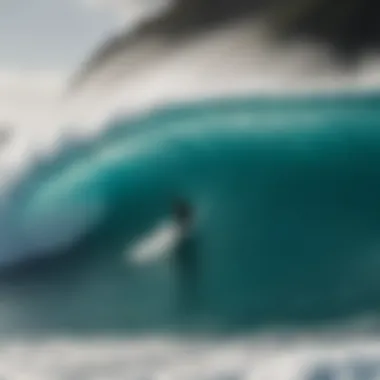
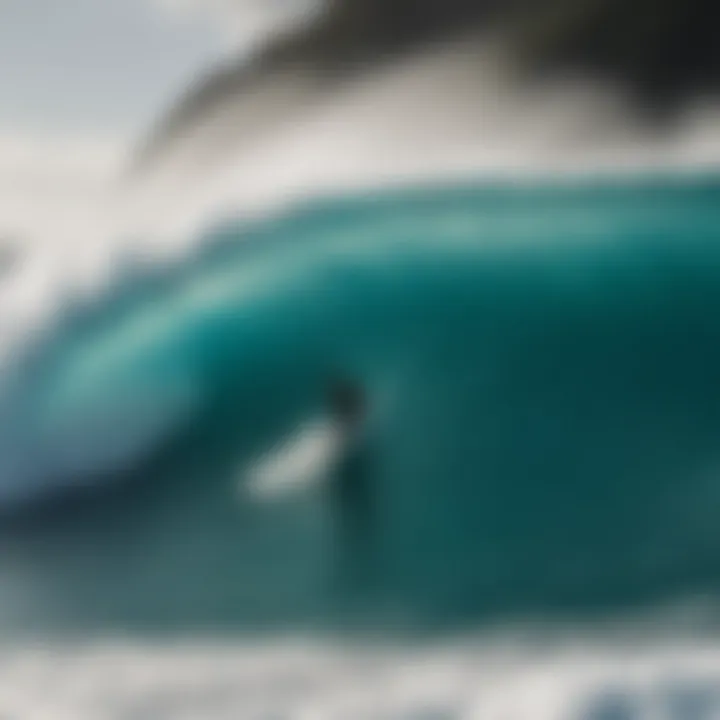
Wearable Technology
GPS and Tracking Devices
In the adrenaline-fueled world of big wave surfing, knowing your surroundings can mean the difference between awe and calamity. That’s where GPS and tracking devices come in, offering detailed wave patterns and conditions to surfers. These gadgets not only track the surf session but also help in analyzing performance during rides.
A significant benefit of these devices is that they provide real-time data on location, ensuring surfers can stay safe and informed about both their position and bigger oceanic changes. It’s like having a lifeguard in the pocket -- ever-reliable.
However, one might consider that over-reliance on tech poses a risk of distraction, causing the surfer to lose focus on the immediate environment instead of what's on the screen.
Surgeon-Wave Analysis
Now, shifting gears to a more analytical side, Surgeon-Wave Analysis leverages sophisticated software to assess surfing techniques through detailed wave data. By analyzing the performance on specific waves, surfers can refine their maneuvers and adapt their strategies accordingly.
This analytical tool is especially advantageous in competitions where understanding wave dynamics can give a competitive edge. Though such tech can be beneficial, it requires surfers to have a grasp of the underlying principles of wave mechanics; otherwise, the analysis might seem like reading a foreign language.
In the end, it is a double-edged sword. The insights gained can propel surfers forward, but only if they're coupled with practical experience and gut instinct. Navigating big waves is both art and science, and technology is helping bridge those two realms as effectively as possible.
Cultural Impact of Big Wave Surfing
The essence of big wave surfing extends far beyond the thrill of riding colossal waves. It has woven itself into the fabric of coastal communities, influencing lifestyles, fostering camaraderie, and raising consciousness about environmental concerns. This section delves into the remarkable societal effects of this extreme sport, particularly its role in establishing a unique culture centered around respect, resilience, and awareness.
Big Wave Community and Brotherhood
At the heart of big wave surfing lies a strong sense of community. Surfers often refer to themselves as a brotherhood, connected not only by the ocean but by shared experiences and values. The bond between these athletes transcends geographical boundaries, creating a network of passionate individuals who support and uplift each other.
Surfers often gather at famed spots like Teahupo'o or Nazaré, forming friendships rooted in common challenges — facing giant waves, coping with fear, and celebrating each other’s achievements. This unity fosters a culture of mentoring, where seasoned surfers pass on knowledge to newcomers, ensuring that the art of riding massive swells continues.
"Surfing isn’t just a sport; it’s a way of life that brings us all together, no matter where we come from. We have each other's backs, and we share a love for the waves that makes us family."
Documenting Big Wave Surfing
The documentation of big wave surfing has surged in popularity, paralleling the sport's growth. From gripping films to captivating social media content, this documentation plays an essential role in spreading the culture and inspiring future generations.
Films and Documentaries
Films and documentaries about big wave surfing do more than capture the spectacular feats of surfers; they serve to educate and inspire. These visual narratives highlight unprecedented rides and the sheer audacity involved in facing nature's might. The portrayal of legendary surfers, such as Laird Hamilton or Garrett McNamara, reveals the grit and tenacity that define this subculture.
One notable aspect of these documentaries is their focus on the environmental challenges associated with big wave surfing, such as oceanic degradation and climate change. By shedding light on these issues, films like "Riding Giants" not only entertain but also propel surfers and audiences to engage more deeply with nature, advocating for sustainability. The unique storytelling found in these films stirs emotions, making them a popular choice and a valuable addition to discussions surrounding surfing.
Photography and Social Media
Photographic documentation of big wave surfing provides a compelling glimpse into the adrenaline-fueled world of these athletes. Capturing moments of bravery, grace, and sometimes peril, photographers reveal the breathtaking beauty and danger of ocean surfing. This medium serves as a visual language, transcending spoken words and reaching a global audience.
Social media platforms, especially Instagram and Facebook, have dramatically changed how the big wave surfing narrative is shared and perceived. Surfers from various backgrounds can showcase their journeys, techniques, and experiences, breaking down barriers that once seemed insurmountable. While this democratization of content sharing has many advantages, including wider engagement and community building, it's worth noting that it can also lead to a superficial understanding of the sport, where the focus may drift towards likes and followers rather than the intrinsic values of surfing.
Environmental Awareness through Surfing
Big wave surfers are increasingly recognized as environmental advocates. The sport's close relationship with the ocean makes surfers keenly aware of ecological changes. Initiatives focused on ocean conservation often find strong support within the big wave community.
Surfers unite to address issues such as plastic pollution, coastal erosion, and habitat destruction. Events and programs aimed at cleaning beaches or raising funds for sustainability projects are commonplace, illustrating a clear intersection between surfing culture and environmental activism.
Future Trends in Big Wave Surfing
Understanding the future trends in big wave surfing is essential for both seasoned riders and newcomers alike. As the sport evolves, it becomes increasingly dependent on technological advancements, environmental changes, and the emergence of promising talent. These elements intertwine to shape not just how the sport is practiced, but also its cultural relevance and sustainability.
Emerging Talents
In recent years, we have witnessed a surge of emerging talents in big wave surfing. Young surfers are stepping up, often bringing fresh perspectives and innovative techniques to the forefront. These newcomers not only challenge the boundaries of what is possible but also infuse the sport with new energy.
Some emerging surfers are even stepping away from traditional training methods, opting for an array of practices that blend physical training with mental preparation. This shift signals a change in how athletes approach the sport. The increased focus on mental toughness is vital as big waves demand not just strength but volition and clarity of thought under pressure. Many of these budding surfers utilize social media to share their journeys, creating communities that rally around shared passions and experiences. This aids in recruitment for competitions and promotes a culture of learning and collaboration.
Adaptation to Climate Change
Climate change presents a looming challenge for big wave surfing, affecting oceanic conditions and weather patterns. The dynamics of wave production are inherently linked to climate, meaning shifts in temperature can alter swell generation. As a result, areas that once served as hotspots may no longer produce reliable waves. This necessitates a proactive approach from the surfing community to address these environmental issues.
Surfers are becoming advocates for sustainable practices, championing responsible surfing etiquette and promoting clean-up days at popular spots. There are also movements to enhance marine conservation policies, ensuring that ocean ecosystems are protected against pollution and climate damage. As surfers become more aware of their impact on the environment, we may witness a shift towards sustainable surf gear and practices that minimize ecological footprints. Keeping tabs on how climate shifts affect coastal areas can help surfers adapt and evolve their practices accordingly.
Surf Competitions Evolution
The world of surf competitions is also undergoing transformations. Traditional formats may give way to newer, more dynamic competition structures that better reflect the evolving nature of big wave riding. With the emergence of electronic scoring systems and real-time performance tracking, judges can provide enhanced feedback, offering insights into each participant's performance more transparently.
Moreover, the inclusion of extreme sports channels and streaming platforms has revolutionized how competitions are consumed by audiences. Surfers can gain more exposure, and fans have access to live broadcasts from even the most remote locations. This growth in visibility can draw sponsorships and inspire a new generation of surfers. Additionally, a focus on inclusivity and diversity is pushing surf competitions to be more accommodating to varied skill levels and backgrounds, ensuring that the future of this extraordinary sport is shaped by a broad array of voices.
Ultimately, these trends highlight the continual evolution and resilience of big wave surfing. Surfers must remain adaptable and aware of both their surroundings and the communities they inhabit. As we navigate this thrilling world, it’s clear that understanding these factors will be crucial for the future generations of surfers.















